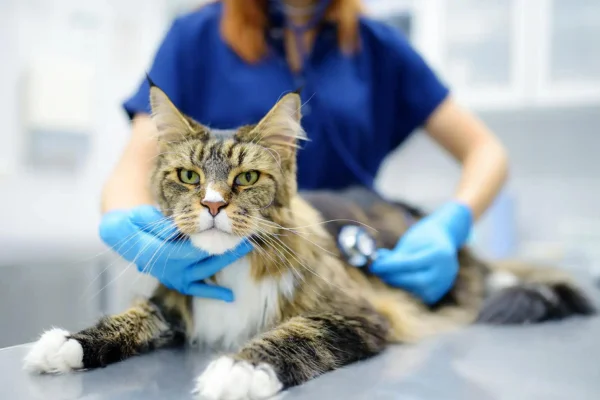Skin Cancer in Cats
Symptoms, Causes and Treatments
Skin cancer is a disease that can affect not only humans, but also our feline friends. Although it may seem rare or distant, skin cancer in cats is a condition that requires attention and, above all, knowledge on the part of guardians.
Knowing how to recognize the early signs can make all the difference to your cat's prognosis and quality of life. In this article, we'll explore the causes, symptoms and treatment options for this condition, as well as highlighting ways to prevent it.
What is Skin Cancer in Cats?
Skin cancer in cats refers to the abnormal and uncontrolled growth of skin cells, which form tumors. These tumors can be benign (non-cancerous) or malignant (cancerous).
Contents
The most common skin cancer in cats is squamous cell carcinoma, which is particularly aggressive and usually appears in areas exposed to the sun, such as the ears, nose and eyelids. There are other types of skin cancer, such as malignant melanoma and mastocytoma, but they are less common in cats.

Risk Factors
There are several factors that can contribute to the development of skin cancer in cats. The main ones are:
- Exposure to the sun: Cats with light or unpigmented coats are more susceptible to damage from the sun's ultraviolet rays. The most vulnerable areas are those with less fur, such as the ears, nose and around the eyes.
- Age: Skin cancer tends to be more common in older cats, although cats of all ages can be affected.
- Race: Some breeds, such as the Siamese cat and the short-haired white cat, may have a genetic predisposition to developing skin cancer due to their lack of pigmentation.
- Compromised immune system: Cats with weakened immune systems, whether due to pre-existing illnesses or treatments such as chemotherapy, may be more vulnerable to skin cancer.
Signs and Symptoms
The symptoms of skin cancer in cats can vary depending on the type and location of the tumor. However, there are common signs that owners should be aware of:
- Wounds that won't heal: One of the most common signs of skin cancer is the appearance of sores or ulcers that take a long time to heal or never heal at all. These lesions are usually located in areas exposed to the sun.
- Growths or lumps: The appearance of nodules, warts or raised areas on the skin can also be an indication of a tumor. These growths may be painless at first, but as they grow they can cause discomfort or pain.
- Changes in Skin Color or Texture: The skin may appear darker, redder or have areas of peeling. Changes in texture, such as thicker or rougher skin, are also warning signs.
- Itching and inflammation: Skin tumors can cause inflammation and intense itching, leading cats to lick or scratch themselves excessively, which can aggravate the lesions.
- Bleeding or discharge: Cancerous lesions can ulcerate, resulting in bleeding or fluid secretion. This can occur anywhere on the body, but is most common in areas exposed to the sun.
Diagnosis
The diagnosis of skin cancer in cats begins with a clinical assessment by a veterinarian. During the examination, the professional will probably take a biopsy of the suspicious lesion or nodule. A biopsy consists of removing a small sample of tissue for laboratory analysis. This test is crucial for determining whether the tumor is benign or malignant and for identifying the specific type of cancer. In addition to the biopsy, imaging tests, such as X-rays or ultrasounds, may be requested to check whether the cancer has spread to other parts of the body.
Common Types of Skin Cancer in Cats
Although squamous cell carcinoma is the most common type of skin cancer in cats, there are other types that also deserve attention:
- Squamous Cell Carcinoma: This cancer mainly affects the cells of the epidermis and is often caused by excessive exposure to the sun. The most affected areas are the nose, eyelids and ears. This type of cancer can be invasive and tends to spread to nearby tissues, although it rarely metastasizes to distant organs.
- Malignant melanoma: Although melanomas are best known in dogs, they can also occur in cats. Malignant melanoma is characterized by the abnormal growth of cells that produce melanin, the pigment that gives skin its color. This type of tumor can spread rapidly to other parts of the body.
- Mastocytoma: Mastocytoma is a tumor of immune system cells known as mast cells. In cats, this type of cancer can appear on the skin or in internal organs such as the spleen and liver. Cutaneous mastocytomas tend to be less aggressive in cats than in dogs.

Treatment
The treatment of skin cancer in cats depends on several factors, including the type of cancer, the stage of the disease and the general health of the animal. The most common treatment options include:
- Surgery: Surgical removal of the tumor is the most effective treatment for many types of skin cancer, especially when diagnosed early. Surgery aims to completely remove the tumor and a margin of healthy tissue around it to ensure that all the cancerous cells are eliminated.
- Cryotherapy: This treatment uses extremely low temperatures to freeze and destroy cancer cells. Cryotherapy is generally used for small superficial tumors.
- Radiotherapy: Radiotherapy is an option when the tumor cannot be completely removed surgically or when you want to reduce the size of the tumor before surgery. This treatment uses radiation to destroy cancer cells and slow down the growth of the tumor.
- Chemotherapy: Although chemotherapy is less common in the treatment of skin cancer in cats, it can be used in advanced or metastatic cases. The aim of chemotherapy is to stop the cancer spreading and improve the animal's quality of life.
- Phototherapy: Photodynamic therapy uses light to activate a photosensitizing agent applied to the cat's skin. This combination of light and chemical agent destroys cancer cells without damaging healthy tissue.
Prevention
Preventing skin cancer in cats is possible, especially in relation to environmental factors. Some of the most effective preventive measures include:
- Sun protection: Keeping your cat out of intense sunlight, especially during the hottest hours of the day, is essential. For cats with light coats or who like to sunbathe, it is advisable to limit the amount of time they are exposed to the sun. In addition, there are specific sunscreens for pets that can be applied to more sensitive areas, such as the ears and nose.
- Regular check-ups: Taking your cat to the vet for routine examinations is one of the best ways to detect skin cancer early. The vet will be able to identify any suspicious signs and recommend more detailed examinations if necessary.
- Skin monitoring: Observing your cat's skin regularly for signs of lesions, sores or lumps can help identify problems at an early stage. If you notice any changes, it's important to seek veterinary advice immediately.
Conclusion
Skin cancer in cats is a serious condition that requires immediate attention. Despite being a frightening diagnosis, early detection and appropriate treatment can significantly improve the animal's prognosis. As owners, it's essential to be aware of the warning signs and take preventative measures to protect our felines. Taking care of your cat's skin health, combined with avoiding sun exposure, could be the key to preventing them from developing this debilitating disease.







